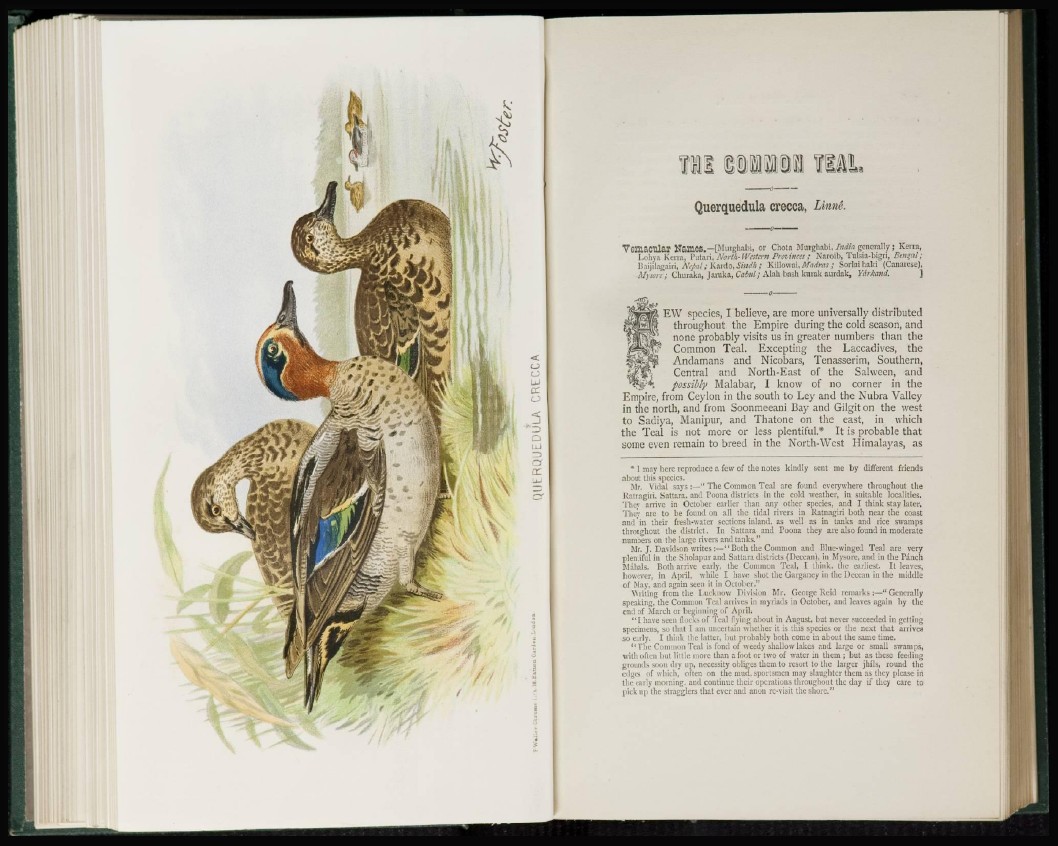
raí conno TOIL
Querquedula crecca, Linné.
Vernacular NamOS.—[Murghabi, or Chota Murghabi. India generally; Kcn-a,
Lohya Kerra, Putari, North- Western Provinces ; Naroib, Tulsia-bigri, Bengal;
Baijilagairi, Nepal; Kardo, Sindh ; Killowai, Madras; Sorlaihaki (Canaiese),
Mysore; Churaka, Jaruka, Cabul; Alali bash kurak aurdak, YArkand. ]
. EW species, I believe, are more universally distributed
throughout the Empire during the cold season, and
none probably visits us in greater numbers than the
Common Teal. Excepting the Laccadives, the
Andamans and Nicobars, Tenasserim, Southern,
Central and North-East of the Salwecn, and
possibly Malabar, I know of no comer in the
Empire, from Ceylon in the south to Ley and the Nubra Valley
in the north, and from Soonmeeani Bay and Gilgiton the west
to Sadiya, Manipur, and Thatone on the east, in which
the Teal is not more or less plentiful.* It is probable that
some even remain to breed in the North-West Himalayas, as
* I may here reproduce a few of the nates kindly sent me by different friends
about this species.
Mr. Vidal says:—" The Common Teal are found everywhere throughout the
Kamagiri. Sattara, and Poona districts in the cold weather, in suitable localities.
They arrive in October earlier than any other species, and I think stay later,
They are to be found on all the tidal rivers in Ratnagiri both near the coast
and in their fresh-water sections inland, as well as in tanks and rice swamps
throughout the district. In Sattara and Poona they are also found in moderate
numbers on the large rivers and tanks."
Mr. J. Davidson writes :—" IJolli the Common and Blue-winged Teal are very
plentiful in the Sholapur and Sattara districts (Deccan). in Mysore, and in the ranch
Mahals. Both arrive early, the Common Teal, I think, the earliest. It leaves,
however, in April, while I have shot the Garganey in the Deecau in the middle
of May. and again seen it in October."
Writing from the Luck now Division Mr. Genrgc Reid remarks;—"Generally
speaking, the Common Teal arrives in myriads in October, and leaves again by the
end of March or beginning of April.
" I have seen flocks of Teal flying about in August, but never succeeded in getting
specimens, so that I am uncertain whether it is this species or the next thai arrives
so early. I think the latter, but probably both come in about the same time,
"The Common Teal is fond of needy shallow lakes and large or small swamps,
with often but little more than a foot or two of water in them ; but as these feeding
grounds soon dry up, necessity obliges them to resort to the larger jhils, round the
edges of which, often on the mud. sportsmen may slaughter them as they please in
the early morning, and continue tlicir operations throughout the day if they care to
pick up the stragglers that ever and anon rc-vit.it the shore."